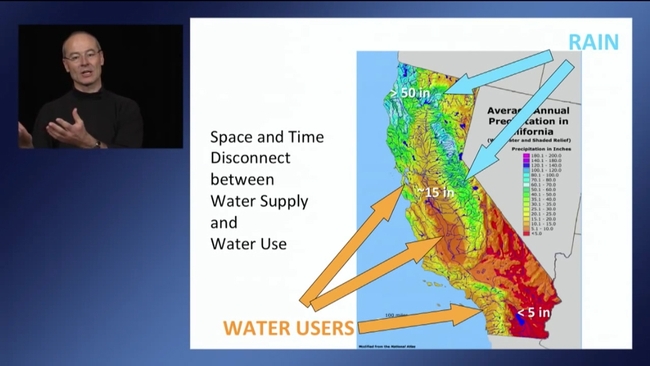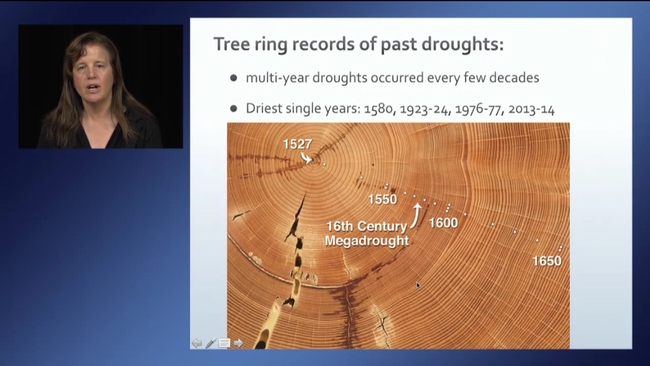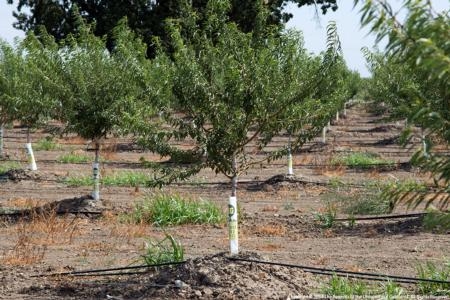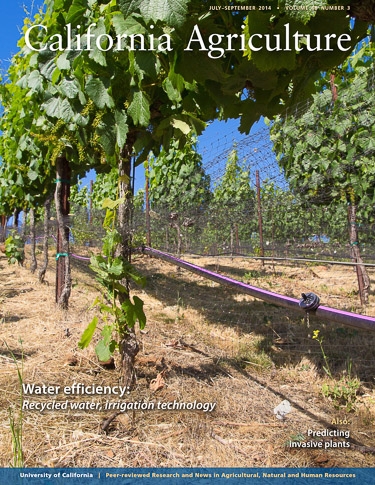- Author: Pamela Kan-Rice

“California will need about 150 percent of normal rainfall this winter to end the drought,” said Doug Parker, director of UC California Institute of Water Resources. “Although the rains have come, we can't afford to let our attention drift away from carefully managing our water supply.”
The UC California Institute of Water Resources, with support from the California Department of Water Resources, has recorded presentations by scientists in the UC system and other organizations on a variety of topics related to water management and drought. “Insights: Water and Drought Online Seminar Series” is accessible by computer or mobile device.
The online seminars enable UC Cooperative Extension and the other scientists to share their knowledge with a larger audience than those who can attend meetings in person, said Daniele Zaccaria, UC Cooperative Extension specialist in agricultural water management in the Department of Land, Air and Water Resources at UC Davis.
“Farmers, landscape professionals, land managers, irrigation consultants, resource managers from water districts and others can view the half-hour video presentations on YouTube whenever it is convenient for them, obtaining science-based information that stems from applied research conducted by several scientists over the last 10 to 15 years,” said Zaccaria, who coordinates the speaker series.

Currently 39 videos addressing drought and water management in different settings are available, and more talks will be added in the coming months. The videos are also being used by Cooperative Extension in other states and have been viewed hundreds of times. “Groundwater and surface water interactions under water shortage,” by Thomas Harter, UC Cooperative Extension specialist in the Department of Land, Air and Water Resources at UC Davis, has been viewed nearly 1,400 times and “Climate change and paleoclimatology: 2013/2014 in perspective” by Lynn Ingram, professor in the Department of Earth and Planetary Science at UC Berkeley, has been more than 800 times.
The following titles have recently been added:
Water resources management in the Pajaro Valley, California
Brian Lockwood, senior hydrologist, Pajaro Valley Water Management Agency
Managing corn under California's drought conditions
Mark Lundy, UC Cooperative Extension advisor in Sutter, Yuba and Glenn counties
Droughts, climate change, and dams: Reconciling a future for California's native inland fishes
Peter Moyle, professor in the Department of Wildlife, Fish & Conservation Biology at UC Davis
Managing landscapes on limited water
Loren Oki, UC Cooperative Extension specialist in the Department of Plant Sciences at UC Davis
Drought - An insidious stress on wildlife
Greg Giusti, UC Cooperative Extension advisor, forests and wildland ecology in Mendocino County
Agricultural water management practices under limited water supply: Lessons from recent droughts
James E. Ayars, agricultural engineer, USDA-ARS
Soil moisture monitoring and utilization during a drought
Dan Munk, UC Cooperative Extension advisor, irrigation, soils and cotton in Fresno County
Land subsidence along the Delta-Mendota Canal and neighboring areas
Michelle Sneed, California Water Science Center, US Geological Survey
How to save water and beautify your landscape ... the sustainable way
Janet Hartin, UC Cooperative Extension advisor, environmental horticulture in San Bernardino and Los Angeles counties
Efficient citrus irrigation
Blake Sanden, UC Cooperative Extension advisor, irrigation and soils in Kern County
Using agroecological practices to enhance the resilience of organic farms to drought
Miguel A. Altieri, professor in the Department of Environmental Science, Policy and Management, UC Berkeley
The drought videos are available at http://ucanr.edu/insights and https://www.youtube.com/UCANR.
- Author: Pamela Kan-Rice

The 2014 Experiment Station Section Excellence in Multistate Research Award presented by the Experiment Station Committee on Organization and Policy on Nov. 2 recognizes the universities' exceptional collaboration on a multistate research project.
Patrick Brown, professor in the Department of Plant Sciences at UC Davis, Jan Hopmans, professor in the Department of Land, Air and Water Resources at UC Davis, Larry Schwankl, UC Cooperative Extension specialist emeritus, and Ken Shackel, professor in the Department of Plant Sciences at UC Davis, are the UC researchers participating in the project “Microirrigation for Sustainable Water Use.”
"The Multistate Research Program is one of the best kept secrets of the land-grant university system, and this award recognizes outstanding interdependent efforts of researchers and extension specialists that have come together to tackle a priority issue that no one institution can address on their own,” said H. Michael Harrington, executive director of the Western Association of Agricultural Experiment Station Directors. “This microirrigation project was selected out of more than 300 multistate projects because, since 1972, the group has made major advances in sustainable agriculture and water conservation.”
Using more precise irrigation management, California growers have increased water use efficiency on processing tomatoes by 54 percent and on almonds by 33 percent since 1990.
Conventional irrigation systems that apply high volumes of water over wide areas can lose a lot of water through runoff, wind, or evaporation. As a result, conventional irrigation systems often over water or under water plants. Instead, microirrigation, or drip, systems use special timers, sensors, and a network of narrow tubes to deliver the right amount of water at the right time.
In the last five years, the group's research has led to new microirrigation equipment and tools that are easier to install, more durable, and more precise. These advances, along with engagement with farmers, have encouraged adoption of microirrigation systems, which has led to significant economic and environmental impacts.
“As director of USDA-NIFA, my goal is to ensure the science we invest in leads to solutions to today's most pressing challenges,” said Sonny Ramaswamy. “One of those challenges is finding ways to feed the growing population while minimally impacting the environment. A safe, reliable supply of water is inextricably linked to food security. The five-fold increase in irrigated acres that took place during the 20th century cannot be repeated in the 21st century — there isn't the space. Instead, we must increase efficiency of the irrigated farmland we have, and that is what this project is doing.”
In addition to UC, other participating land-grant institutions include Auburn University, University of Arizona, Colorado State University, University of Florida, University of Hawaii, University of Idaho, Iowa State University, Kansas State University, Mississippi State University, University of Nebraska, New Mexico State University, Cornell University, Oregon State University, University of Puerto Rico, Texas A&M AgriLife Research, University of the Virgin Islands, Washington State University, and University of Wyoming. The universities collaborated with the USDA's Natural Resources Conservation Service and Agricultural Research Service.
The award was presented by ESCOP chair Bob Shulstad and Ramaswamy at the Association of Public and Land-Grant Universities annual meeting in Orlando, Fla.
The project's name will be added to a plaque at the USDA Waterfront Centre in Washington, D.C., and the group will receive $15,000 to support their ongoing work. The group's continued efforts are more critical than ever as the U.S. continues to experience extreme droughts that threaten water supplies and crops that depend on irrigation.
These efforts are supported, in part, through USDA-NIFA by the Multistate Research Fund, established in 1998 by the Agricultural Research, Extension, and Education Reform Act (an amendment to the Hatch Act of 1888) to encourage and enhance multistate, multidisciplinary agricultural research on critical issues. Additional funds were provided by contracts and grants to participating scientists. For more information about the microirrigation project, visit http://www.cropinfo.net/MI.
- Author: Debbie Thompson
New UC research shows recycled water is suitable for Napa vineyards, but adds chloride to Salinas Valley soil.

"This drought is unprecedented — we've never had such a lack of rainfall since we started keeping track," says Doug Parker, who directs UC ANR's California Institute for Water Resources and also leads UC ANR's Strategic Initiative on Water Quality, Quantity and Security. "Farmers are looking for ways they can stretch their water budget."
One way is irrigating vineyards with recycled wastewater from municipal waste treatment plants. California recycles only 7 percent of the 9 million acre-feet of urban wastewater produced per year, and the state wants to nearly quadruple that by 2030. Besides providing a source of irrigation water during drought, recycling water is cost-effective and reduces wastewater discharge to rivers.
To see if recycled water is suitable for use in Napa vineyards, UC Cooperative Extension researchers evaluated the quality of water treated by the Napa Sanitation District (NSD) as well as its impact on soil. They found that the quality of the recycled water was similar to that of other local sources of irrigation water. Additionally, in a vineyard that was irrigated with recycled water for 8 years, the soil did not accumulate salts or toxic ions, such as boron.
"Our work suggests that treated wastewater from the NSD is suitable for irrigation of vineyards over the long term," the researchers say.
One caveat is that the recycled water was relatively high in nitrogen. The higher soil nitrogen levels will be fine for many vineyards but, when needed, growers can easily reduce nitrogen by planting cover crops such as cereals and other grasses during the winter.
Also in this issue:
Recycled water increases chloride in Salinas Valley soil
Most growers in the northern Salinas Valley have irrigated their crops with recycled wastewater since 1998, raising concerns about salt accumulation in the soil. New research shows that since the year 2000, only a small amount of sodium has accumulated in the 12-inch deep rooting zone. In half of the fields studied, chloride has accumulated to levels that could affect yields of strawberry plants and leafy greens such as spinach. This chloride buildup may be due to the recent lack of winter rainfall, which normally washes salts out of the root zone, and could be mitigated by improving drainage and avoiding soil amendments that contain chloride.
Reducing runoff from alfalfa fields
Accounting for nearly 20 percent of total agricultural water use statewide, alfalfa is California's thirstiest crop — large amounts of irrigation water can be wasted as runoff. New UC research shows that alfalfa growers can reduce this runoff to a comparative trickle by using a mathematical model that predicts the advance of irrigation water across a field in combination with wireless sensors that track the water's advance. This new approach also frees growers from checking the irrigation status of fields in person, saving time and labor.
Predicting which plants will invade California
Most ornamental plants are happy to stay in gardens, but some jump the fence, invading wildlands and crowding out native plants. California has a wealth of native plants, about 3,400 species, but is also plagued by more than 1,500 species of invasive plants, many of which were introduced by the horticultural trade. New UC research identifies 186 ornamentals that have invaded Mediterranean areas in other parts of the world, and so are at high risk of becoming invasive here too. This work could help focus further risk assessments of imported ornamentals, as well as help land managers identify which species to watch for in wildlands.
The entire July-September 2014 issue can be downloaded at http://californiaagriculture.ucanr.edu.
California Agriculture is the University of California's peer-reviewed journal of research in agricultural, human and natural resources. For a free subscription, go to http://californiaagriculture.ucanr.edu or write to calag@ucanr.edu.
- Author: Pamela Kan-Rice
“A significant number of regions in California won't have groundwater available in another generation or two if we continue business as usual.” -- UC scientists Thomas Harter and Helen Dahlke

In the special edition of California Agriculture released today (July 16), UC Cooperative Extension specialist and UC Davis professor Thomas Harter and UC Davis professor Helen Dahlke call attention to the stress being placed on California's aquifers as well as the catastrophic consequences of not having this hidden resource available in future droughts.
In the University of California's premiere journal for agricultural research, the groundwater experts make the following key recommendations:
- Groundwater is most effectively managed at the local or regional basin level, with support from the state.
- Local groundwater management entities must be given better tools, such as clear mandates to assess, measure, monitor and allocate their groundwater and control its extraction.
- The definition of groundwater sustainability can be set at the state level and translated into specific actionable thresholds that must be enforced locally, with a credible threat of state enforcement should the local efforts be unsuccessful.
- Much better data collection, analysis, reporting and data integration are needed to provide transparency, to support local management efforts and to properly inform the public. This requires much stronger planning and support within the DWR and SWB.
“Fundamentally, even more needs to be done," Harter and Dahlke write. "Local land-use decisions on urban and agricultural development, which have critical impacts on groundwater resources, must be consistent with groundwater management objectives. This will require significant communication between land-use and groundwater managers. Effective integration with water quality management and surface water management efforts, which are governed separately, is also required. And none of these efforts can occur without sustained funding through a mix of local and state sources.”
In their outlook article, Harter and Dahlke also explore one of the most promising ideas to protect our aquifers: groundwater banking.
The idea is that during storms or flood control releases, excess surface water could be directed from streams via existing water conveyance systems onto dormant or fallow agricultural fields, which would then serve as infiltration basins. Solutions need to be developed to add significant recharge to California's aquifers, often during relatively short periods when excess surface water is available.
A 3-year project, funded by UC Division of Agriculture and Natural Resources, aims to look at the feasibility of such groundwater recharge activities by setting up pilot groundwater recharge field experiments, which would provide valuable data to address concerns about the costs and risks to crops, the influence these projects may have on groundwater levels and flows, and the possibility of recharging contaminated water or degrading groundwater quality by leaching contaminants such as nitrate from the vadose zone. Data collected could serve as a foundation for developing economic incentives at the local, state or federal level to acknowledge the landowner's service to the local community and California's water supply reliability.
To read their entire article, "Out of sight but not out of mind: California refocuses on groundwater,” and the special "Water efficiency" edition of California Agriculture, visit http://californiaagriculture.ucanr.edu and http://ucanr.edu/repositoryfiles/cav6803p54-136027.pdf.
Further reading:
UC Cooperative Extension Groundwater Program http://groundwater.ucdavis.edu
Helen Dahlke's groundwater banking project http://dahlke.ucdavis.edu/research/groundwater-banking
California Water Action Plan: Improving Groundwater Management (links to state policy and emerging legislation) http://groundwater.ca.gov
California Department of Water Resources report to the Governor's Drought Task Force http://www.water.ca.gov/waterconditions/docs/Drought_Response-Groundwater_Basins_April30_Final_BC.pdf
California Water Plan Update 2013 http://www.waterplan.water.ca.gov/cwpu2013
Association of California Water Agencies Recommendations for Achieving Groundwater Sustainability http://www.acwa.com/sites/default/files/post/groundwater/2014/04/final_acwa-groundwater-sustainability-recommendations.pdf
- Author: Pamela Kan-Rice
- Author: Nancy Vogel, DWR public affairs, nancy.vogel@water.ca.gov

Depending upon local conditions and near-term weather, irrigation may not be needed for a month or more.
"We can reap twice as much from the latest storms if people take full advantage of the natural precipitation and shut off sprinklers," said Department of Water Resources Director Mark Cowin. "Three dry years in a row have left our major reservoirs low, and we need to conserve those supplies in case drought conditions persist into the next rainy season. There's no need to water lawns, parks, median strips, or any landscaping already soaked by these recent storms."
On January 17, Governor Edmund G. Brown Jr. declared a drought emergency in California and called on all residents to conserve water by 20 percent in their homes and businesses. Typically more than half of the water used by homeowners is used outdoors. Californians can go a long way toward meeting the governor's goal by shutting down sprinklers until soil several inches deep appears dry or plants appear stressed. People who resume landscape irrigation should do so only according to the water schedules set by their local water districts. More than 100 such districts around the state have imposed voluntary or mandatory conservation measures that restrict the days and times when residents can run sprinklers.

Tom Gohring, executive director of the Water Forum, a diverse group of Sacramento regional interests working to resolve water issues, hosted the event at his home and switched off the sprinkler system controller in his garage to encourage others to do the same.
"Many people think they use more water in their house than they do in their yard," said Gohring. "The opposite is typically true. In the Sacramento region, about 65 percent of water used by homeowners goes to irrigate landscaping. We always want people to adjust their sprinklers based on the season and weather, but now, after a record dry year, there's real urgency."
While recent storms have boosted the Sierra Nevada snowpack and runoff into reservoirs, it would take half an inch of rain every day of March from Redding to Bakersfield to bring the state to average precipitation for the year in the watersheds that supply much of California's drinking and irrigation water. Even average precipitation would not be enough to avert water shortages, because major reservoir storage is now so far below typical storage for this time of year.
“Storms in the last couple of weeks have delivered a couple of inches or more of precipitation to most parts of California,” said Chuck Ingels, UC Cooperative Extension advisor in Sacramento County. “Trees, shrubs, flowers, and lawns naturally use less water in winter's cool temperatures, and so an inch of rain provides enough moisture to forego the need for sprinklers for up to several weeks depending on temperatures.”
Sprinkler systems are controlled by a device, called an irrigation controller, that triggers the irrigation system when to turn on and off. People who do not know how to program their controllers can get links to manuals published by major manufacturers at the Save Our H2O website, saveourH20.org. Look under the "Sprinklers 101" section of the website: http://www.saveourH20.org/sprinklers101
Sacramento residents can find their water provider, information on the latest water restrictions, and water-saving tips at the Regional Water Authority's “Be Water Smart” website at http://www.bewatersmart.info/residential-customers/.
University of California master gardeners offer tips for gardening during a drought at http://cagardenweb.ucanr.edu. The California Center for Urban Horticulture, UC Davis, also has information for conserving water in the landscape, http://ccuh.ucdavis.edu, as does the UC Davis Arboretum http://publicgarden.ucdavis.edu/public-garden/drought-resources.
Other smart watering tips detailed at the Save Our H2O website:
- Water only in the early morning or late evening. Cooler temperatures reduce evaporation.
- Check your sprinkler system frequently and adjust so that you are not watering the hose, sidewalk, or street.
- Put mulch around trees and plants to cool soil and reduce evaporation.
- Consider installing a drip irrigation system, which applies water precisely, with less waste.
- Choose plants based on their adaptability to your climate. Check the Sunset Plant Finder to learn about water-wise plants that thrive in your region: plantfinder.sunset.com/plant-home.jsp.
- If you find yourself walking on your lawn only to mow it, consider replacing it with water-wise landscaping that reduces the need for water and maintenance.
- Check with your local water district for a free visit from a water conservation specialist, rebates on water-wise appliances, or "cash for grass" incentives to replace lawn with water-wise landscaping.
With California facing one of the most severe droughts on record, Governor Brown declared a drought State of Emergency last month and directed state officials to take all necessary actions to prepare for water shortages, and the governor, joined by legislative leaders, announced legislation to immediately help communities deal with the devastating dry conditions affecting our state and to provide funding to increase local water supplies.
Governor Brown met with President Obama about crucial federal support during the ongoing drought earlier this month, and the state continues to work with federal partners to ensure coordinated drought monitoring and response. Governor Brown and the administration have also expressed support for federal legislation introduced by Senators Feinstein and Boxer and Representatives Jim Costa, Tony Cárdenas and Sam Farr.
Across state government, action is being taken. The Department of General Services is leading water conservation efforts at state facilities, and the California State Architect has asked California school districts and community colleges to act on the governor's call to reduce water usage. The Department of Transportation is cutting water usage along California's roadways by 50 percent. Caltrans has also launched a public awareness campaign, putting a water conservation message on their more than 700 electronic highway signs.
In January, the state took action to conserve water in numerous Northern California reservoirs to meet minimum needs for operations impacting the environment and the economy, and recently the Department of Water Resources and U.S. Bureau of Reclamation announced they would seek the authority to make water exchanges to deliver water to those who need it most. The State Water Resources Control Board announced it would work with hydropower generators and the Federal Energy Regulatory Commission to preserve water in California reservoirs. Recently the California Department of Fish and Wildlife and the California Fish and Game Commission restricted fishing on some waterways due to low water flows worsened by the drought.
The state is working to protect local communities from the dangers of extreme drought. The California Department of Public Health identified and offered assistance to communities at risk of severe drinking water shortages and is working with other state and local agencies to develop solutions for vulnerable communities. CAL FIRE hired additional firefighters and is continuously adjusting staffing throughout the state to help address the increased fire threat due to drought conditions. The California Department of Food and Agriculture (CDFA) launched a drought website to help farmers, ranchers and farmworkers find resources and assistance programs that may be available to them during the drought.
Even as the state deals with the immediate impacts of the drought, it's also planning for the future. Recently, the California Natural Resources Agency, the California Environmental Protection Agency and CDFA released the California Water Action Plan, which will guide state efforts to enhance water supply reliability, restore damaged and destroyed ecosystems and improve the resilience of our infrastructure.
Governor Brown has called on all Californians to voluntarily reduce their water usage by 20 percent, and the Save Our Water campaign launched four public service announcements encouraging residents to conserve, and has resources available in Spanish. Last December, the governor formed a Drought Task Force to review expected water allocations and California's preparedness for water scarcity. In May 2013, Governor Brown issued an Executive Order to direct state water officials to expedite the review and processing of voluntary transfers of water.


